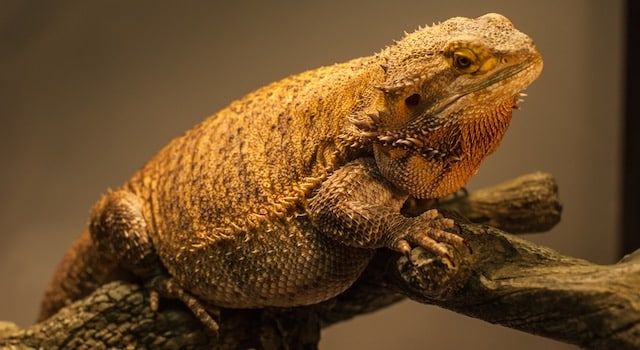
Introduction to Bearded Dragon Obesity
Bearded Dragon obesity is a common yet easily preventable health concern. A bearded dragon is considered obese when abnormal or excessive fat accumulation may impair their health. Their weight can vary depending on their species and size, but most adult bearded dragons between 15-24 inches long weigh about 250 to 700 grams (8.8-24 ounces). An obese bearded dragon will have visible fat deposits and bulging fatty pads (located behind their eyes). Obesity is associated with various health issues such as heart disease, impaired mobility, and potentially even a reduced lifespan.
Ensuring your bearded dragon maintains a healthy weight is essential for their health and well-being. Diet and exercise are critical in preventing obesity and keeping your bearded dragon healthy.
Signs of Bearded Dragon Obesity
Both physical and behavioral signs can identify obesity in bearded dragons.
Physical Indicators
- Armpit Fat: Fat deposits around the armpits.
- Prominent Jowls: Fat deposits under the jawline (jowls).
- Excess Skin Folds: Along the neck, abdomen, and limbs.
- Large Fat Pads: Large fat pads (located behind the eyes).
- Inability to feel spine or ribs due to excess body fat.
- Distended Belly: Large, protruding stomach and visible bulges.
- Thick Tail Base: A bulging and enlarged tail base.
Behavioral Indicators
- Sluggishness: Moving and behaving slower than usual.
- Difficulty Climbing: Struggling to climb or maintain balance.
- Difficulty Moving: Excess weight strains their muscles and joints, making it difficult to move comfortably.
Common Causes of Bearded Dragon Obesity
1. Dietary Issues
Dietary issues are the leading cause of obesity in bearded dragons, ranging from overfeeding large portions and fatty foods to limited greens in the diet. Overfeeding foods high in fat and protein, like insects (specifically wax worms, mealworms, and superworms), can also contribute to excessive weight gain.
Regardless of age, bearded dragons need a balanced diet of live feeder insects, fresh vegetables, and dietary supplements such as calcium and vitamin D3. Vegetables play a crucial role in maintaining a healthy weight and preventing obesity. This is because they are low in calories and fat but high in fiber and essential vitamins and minerals that support a healthy weight and digestive system.
2. Lack of Proper Exercise
Just like us, bearded dragons need exercise to stay fit and healthy. However, they cannot lift weights or run on the treadmill and instead need to exercise daily by climbing, exploring a spacious enclosure, free-roaming, and interactive playtime. Small enclosures are restrictive and limit your beardie’s space to move around and exercise. That’s why keeping them in a large enclosure above the minimum recommended size of 120 gallons for an adult is vital.
Bearded dragons are semi-arboreal and love to climb branches, rocks, and platforms in their enclosure. This is great for mental and physical enrichment and is a natural form of exercise. Free roaming outside the cage is another exercise they can benefit from and helps keep them fit and active.
3. Poor Husbandry
Bearded dragons bask for about 12 hours daily and don’t typically move much during this time. However, it’s important not to interpret this as laziness and instead leave them to bask without disturbing them. They must bask for thermoregulation and digestion and absorb UVB light to produce vitamin D3. A lack of a proper basking area can lead to lethargy and sluggishness and interfere with how they move around. Bearded dragons won’t move much if they are too cold or struggling to digest and use the energy from their food. Furthermore, they must produce vitamin D3 to digest calcium and maintain strong and healthy bones and muscles.
4. Feeding Beyond Needs
Even if it is the correct balance of insects and greens, overfeeding is also an issue. Bearded dragons require specific portion sizes according to their age and size. Hatchlings and juveniles will need slightly smaller and more frequent food portions than adults, primarily because of the different metabolic and energy requirements to support growth and development. Overeating combined with a lack of proper exercise is guaranteed to contribute to obesity in your bearded dragon.
Health Risks of Bearded Dragon Obesity
Obesity strains nearly every part of your bearded dragon’s body, including the muscles, joints, organs, skin, and metabolism.
- Fatty Liver Disease (Hepatic Lipidosis): This occurs when an increase of fat in the liver is significant enough to cause disease and adversely affect liver function. The most common cause of this disease is overfeeding.
- Difficulty Shedding: Bearded dragons might experience difficulty shedding because the excess fat interferes with the natural shedding. Excess fat can stretch the skin and reduce its elasticity, making it more likely for the old skin to get stuck (retained shed). Reduced mobility can make it difficult for bearded dragons to move around, impacting the wear and tear needed to loosen the old skin. The fat deposits can also obstruct the old skin, especially around the limbs, tail, and neck.
- Organ Failure: Obesity can contribute to cardiovascular issues, respiratory problems, and liver dysfunction. Excess puts a lot of strain on the heart, which could result in heart failure over time as the heart struggles to pump blood effectively throughout the body. It also affects the respiratory system due to excess fat around the chest and stomach, restricting the movement of the lungs.
- Metabolic Disorders: Obesity disrupts normal metabolic functions and could potentially lead to metabolic bone disease (MBD). Limited movement, overfeeding the wrong foods, and a lack of UVB lighting that may have contributed to obesity can also cause metabolic bone disease.
- Joint and Bone Disorders: Excess fat puts a lot of strain on the bones and joints, leading to discomfort and joint deterioration over time.
- Reduced Lifespan: Most health issues associated with obesity can also contribute to a shorter lifespan and negatively affect your bearded dragons’ quality of life.
Prevention Strategies
Balanced Diet and Appropriate Food Portions
The most effective way to prevent your bearded dragon from becoming obese is to feed them a balanced diet and appropriate food portions. You want to avoid overfeeding them, especially insects high in protein and fat. The number of insects they should eat depends on their age and weight. Generally, crickets and dubia roaches are the main recommended types of insects to feed. They have less fat and calories than many other feeders, such as mealworms and superworms, which should be fed sparingly due to their high fat content.
If you are unsure about the exact portion sizes for your bearded dragons, it’s best to consult with a veterinarian who can help you determine the right amount based on their age, size, and weight.
Daily Exercise and a Spacious Enclosure
Bearded dragons need exercise daily to maintain a healthy weight and mental enrichment. You can encourage your bearded dragon to exercise by providing a spacious enclosure of at least 120 gallons. A spacious enclosure encourages them to move around comfortably and explore. You should also ensure they have various branches, rocks, and platforms to climb in the enclosure, a natural behavior they display in the wild.
Steps to Manage an Overweight Bearded Dragon
Suppose your bearded dragon is overweight and shows signs of obesity. In that case, the first and most important step to manage this condition is to take them to an exotic veterinarian for a health evaluation. This is crucial for detecting any potential health issues that could be causing or caused by obesity. The veterinarian will weigh your bearded dragon and help you create an appropriate weight loss plan based on weight, age, size, and lifestyle.
- Controlled Portion Sizes: With the advice of a veterinarian, your bearded dragon may need smaller or less frequent portions of food. This is primarily the case if they become obese due to overfeeding large portions of food or foods high in fat and calories.
- Switching Insects: If your bearded dragon eats a lot of insects high in protein and fat, like wax worms, mealworms, and superworms, changing them to crickets and dubia roaches as a primary protein source can help with weight loss.
- Adding More Greens: If their diet is limited or lacks greens, gradually introduce more vegetables into their daily diet. Vegetables are an excellent source of fiber and essential vitamins and minerals that support healthy weight management and metabolism.
- Encouraging Movement: Add climbing branches, rocks, platforms, hammocks, and other obstacles that encourage climbing.
- Health Monitoring: Take your bearded dragon for regular checkups at the veterinarian to monitor their weight loss progress and potential health issues.
Myths About Bearded Dragon Weight
1. Fat Dragons Are Healthy Dragons
There is a common misconception that a fat bearded dragon is a sign that they are healthy and happy, but this is false. Although they may look cute and well-fed, obesity is not healthy for them. It puts them at risk of developing serious health problems such as cardiovascular issues and liver dysfunction. A healthy bearded dragon will be at an appropriate weight for their age and size and show no signs of obesity.
2. Beardies Can Eat as Much as They Want
Although it might feel natural to let your beardie eat as much as they want whenever they want, this is not healthy. Bearded dragons need controlled feeding to maintain a healthy weight and to prevent overfeeding, which can contribute to obesity and fatty liver disease. Always ensure they eat the correct portion sizes for their age and size.
When to Seek Veterinary Help
It’s a good idea to consult with a veterinarian if your bearded dragon shows signs of obesity and underlying health problems. However, certain cases require immediate veterinary help, like if your bearded dragon has difficulty breathing, moving, or thermoregulating or has sudden changes in appetite and behavior. Furthermore, a vet trip is necessary if your bearded dragon isn’t losing weight even with a balanced diet and exercise.
Conclusion
Obesity is a serious yet preventable condition typically caused by dietary and feeding issues, lack of proper exercise, and poor husbandry. Common signs to look out for include excess fat deposits near the neck, face, stomach, limbs, and tail base, and sluggish behavior. Obesity can cause serious health issues if left untreated and often requires a weight management plan created by a veterinarian. Thankfully, it’s relatively easy to do with proper care, a balanced diet, and daily exercise.



